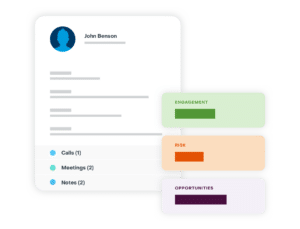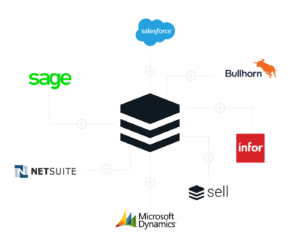How to Build a Marketing Strategy in Alignment With Sales Goals
One of sales’ biggest complaints about marketing is that it claims it’s responsible for “driving sales.” But does it?
Without true alignment, every email nurture campaign, whitepaper, blog, or webinar marketing produces is a wasted effort. Marketing activities fuel sales opportunities—and when they’re not in sync, neither one thrives.
To ensure total alignment, marketing teams must start with a strategy that accounts for and visibly supports sales goals. Tactics like regular collaboration and marketing automation can help.
Best Practices for Sales and Marketing Alignment
-
Get to Know Each Other
Perhaps the easiest tactic for aligning your sales and marketing teams is spending more time together. Do your sales reps and marketing team members even know each other? Build rapport and culture with quarterly mixers, training, or lunch-and-learns—anything that puts both teams face to face. If your teams work virtually or it’s difficult to meet in-person, explore ideas for socializing online like happy hours via Zoom. To help employees continue the conversation, implement an online chat tool to make communication quick and convenient. Sales and marketing don’t have to be best friends, but they have to align toward the same goals.
-
Meet Regularly
In the past, regular collaboration meant recurring meetings. But in the digital, work-from-home area, this might mean Zoom calls, instant messages, texts, emails, and in-app notifications within common software like CRM. Every sales and marketing touchpoint is valuable. And while full team-to-team collaboration is beneficial, the most critical connections are among leaders. If sales and marketing leaders agree on goals, the right priorities and focus will trickle down among all teams and employees.
-
Work Together
While social events and regular meetings are a step in the right direction, the day-to-day work is most important. Sales and marketing must be able to easily collaborate in the systems and environments they’re present in every day. Set sales up for success with items like:
- Promotional copy, quick summaries, and enablement details for each new piece of content
- Helpful communications for each funnel stage (e.g., nurture campaign email copy, follow-up copy, pitch decks, etc.)
- Case studies from current, satisfied customers to help support new deals
More importantly, regularly gather feedback from sales to discover what’s working and what’s not. Then, modify your support materials to help sales tailor their approach and ultimately achieve team goals.
-
Identify Common Goals
While budgets vary across industries, most businesses spend between 20 and 45% of their business revenue on sales and marketing. Creating alignment ensures that money doesn’t go to waste and optimizes the company’s investment for a greater return. Goals hold you accountable to achieving key performance indicators (KPIs) and are milestones to achieving your company’s overall vision. Before simply setting goals to achieve common metrics that other companies strive for, ask your teams:
- What do you want to accomplish and why?
- What tasks and initiatives will help you accomplish these goals?
- What roadblocks could keep you from achieving these goals?
- What support or resources will you need to meet your goals?
- How can the other team help you achieve these goals?
Answering these questions will most likely drive you to set goals around categories like lead generation, lead conversion, profit margin, annual revenue growth, and customer retention. Once set, make sure goals are accessible and visible to both teams and check the process regularly.
-
Develop a Content and Marketing Plan
A marketing plan is not the same as a marketing strategy. Your strategy is your overall vision of what you want to accomplish. Your marketing plan is your roadmap for execution. It typically includes specific projects and tasks, resources and systems, and key players. As a marketer, developing a content and marketing plan shows how the pieces your team produces will directly affect sales and overall company success. Start by answering important questions like:
- Who is your primary audience? (customers, prospects, researchers)
- What problems will you solve for them? (how-tos, industry education, trends)
- How is your content different from competitors? (voice, tone, uniqueness)
- What content mediums will you use? (blogs, videos, whitepapers, podcasts)
- What channels will you promote on? (Twitter, LinkedIn, industry publications)
- How will you manage the content creation process? (content management systems (CMS), spreadsheets, project management)
What Kinds of Tools Help Sales and Marketing Align Best?
Even after you’ve made introductions, had meetings, and forged plans, your sales and marketing teams still need tools to keep them on the right path. Technology helps modern teams keep up with the fast pace of business, meet customer expectations, and innovate beyond the competition. Luckily, there’s a tool for every need.
Communication Platform
Business communication has evolved from in-person conversation and snail mail to email and text. While all of these communication types are still in use in some capacity, teams today must also navigate virtual and remote work. They require person-to-person communications that are as fast as they are efficient. Chat tools like Google Chat and Microsoft Teams let users instantly message each other, while social intranets provide a central hub for collaboration. Some sales and marketing platforms have built-in communication tools to easily notify, alert, and collaborate with users across key accounts and goals.
Customer Relationship Management (CRM)
A CRM is essential to manage accounts and maintain visibility across customers. But with more than 2,200 available providers, how do you choose the best CRM? Look for one that does the work for you and takes busy work off your hands to focus on strategy and execution. Work with sales to identify a robust system to meet their needs, but intuitive enough to help marketers manage the customer journey.
Marketing Automation
A marketing automation system does the behind-the-scenes work of marketing operations so team members can focus on creating engaging content, qualifying the best leads, and collaborating with sales. Sales teams that are misaligned often reject marketing qualified leads because they’re not warm enough. The best digital marketing platforms can remove the guesswork to help you predict which leads are most likely to close. Then, automate communication cadences to keep them engaged until they’re ready for sales.
Sales Acceleration
Sales also accuses marketing of a lack of support. Instead of guessing what actions to take with which accounts, let a sales automation platform accelerate the process with directives for the next best action. AI can predict which actions will be the most fruitful, maximizing productivity and sales velocity using data from past deals and external industry sources.
Activity Management and Attribution
Do you know where your leads, customers, and revenue come from? Attribution technology gives you a clear picture of your lead sources by capturing the data to enter it into your CRM. Or, use activity management to monitor activities assigned to individual team members and track which ones are most beneficial.
SugarCRM Removes Silos to Align Sales and Marketing
SugarCRM provides a platform where your sales and marketing teams can finally work together. Sugar Market and Sugar Sell allow your teams to see all prospects and customers across their entire journey—in high definition. Our platform removes silos between sales and marketing so they can constantly communicate, view real-time status updates, predict the next best actions, and monitor progress toward collective goals.
Sugar Market sets sales up for success by attracting more visitors, automating redundant processes, and capturing and nurturing leads so they’re as warm as possible.
Sugar Sell brings the process home by organizing and streamlining your CRM data, customizing workflows for the most efficient use, and accurately predicting the strongest sales opportunities.
Experience the power of true sales and marketing alignment. Get the visibility you need by watching a demo today.



